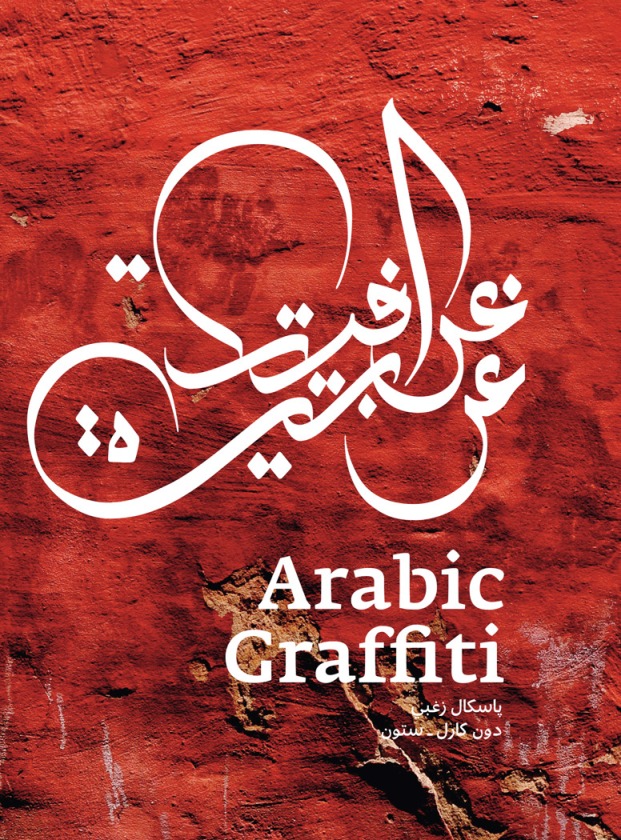
When it comes to Arabic type design, the first thing that comes to most people's minds is "calligraphy". While this form of art is revered and admired in this region, there are others that are far less noticed. Arabic graffiti, an art form that has always been present, yet highly undervalued in its importance, is slowly gaining recognition in the industry.
Lebanese typographer Pascal Zoghbi and German graffiti writer Don Karl, chose this subject matter for their book Arabic Graffiti. The 200 page book, illustrated with over 300 images, explores the different types of contemporary graffiti, urban calligraphy and type design in Arabic writing. It also includes contributions by experts in the field, including Huda Smitshuijzen AbiFarès, Rana Jarbou, Tala F. Saleh and William Parry, as well as artwork by eL Seed, Hest1 and more.

Most importantly, the book brings to light the emergence of this significant movement in the Middle East, and the different socio-cultural events that shaped it. As Don Karl explains, "We differentiate between “Graffiti Writing” – which is a global art movement – and “Graffiti” which can simply be any writing on a public wall. In the book we show mainly artistic examples but it can be Calligraphy on trucks, Palestinian Graffiti, Islamic Scripture on walls, political slogans or stencils and so on."
We spoke to Don Karl about his book and learned more about this significant art movement…
What inspired you to create this book?
We found out that around the world the transformation [of Graffiti Writing] had in fact already started and that professional Graffiti Artists from Jarkata to Tehran, from Paris to Montreal had already integrated classical elements of Arabic Calligraphy.
Seeing those works and following the current rapid spread of Urban Art all around the Middle East, we decided the time was right to do this book.

Have you noticed that graffiti changes from one Arab region to another?
I have to say the book is not about Arab Graffiti but Arabic Graffiti, so it includes examples from Iran and designers from Pakistan as well. The Arabic script is used in a very huge region, so of course there is a lot of difference between each place. That’s why we have included many very different types of public art and Graffiti in the book.
What trends do you see with Arabic graffiti?
The increasing use of the knowledge and aesthetics of classical Arabic Calligraphy while bending and often breaking many of its rules. This is what Graffiti is all about. Deconstructing letters and putting them together in new and inspiring forms. But I also see many young artists coming up with a lot of energy all over the place.
Why do you think there is a shift towards using Arabic calligraphy instead of the typical Western lettering?
Well, as an outsider I guess that’s because this is your script and your heritage. And it probably helps that Arabic Calligraphy is so beautiful.

What regions in the Arab world are more graffiti condensed, and what areas did you notice have the least interest in it?
Wow, that’s a tough question. When we started with the book we thought we could cover every country and show every local Graffiti scene. But we soon realized that we would have to research and travel for many years to do that properly. We were lucky that we found really great authors who were specialists in specific topics that we wanted to cover. Their essays and photos were a great contribution without which we could not have done it.
As for your question, I think Tehran and Beirut have probably the most evolved graffiti scenes. But you can find great Urban Artists everywhere, in the Gulf countries as well as in North Africa. A lot is happening currently in Egypt and Tunisia.

What's in the future for Arabic graffiti, calligraphy and type design?
I learned a lot from Pascal, but I can’t really speak about type design. As for Contemporary Arabic Calligraphy, I am positive that many more artists will continue the current experiments and that this beautiful art that many already thought of as a dead art form, will in fact thrive and give us more joy and beauty.
As for Graffiti Writing, it is just the same. It was already declared dead several times too. But this movement was never larger, more global and more accomplished in its art as it is today. Kids who write crude graffiti today will be skilled artists in a few years and the movement will be even larger. Arabic Graffiti will grow and get more and more beautiful. Mark my words.

Stone aka Don Karl is a graffiti writer, author and publisher in Berlin. He started to write graffiti in 1983 and published his first book on train writing in 1986. He has participated in and curated various international urban art exhibitions and projects, such as Cubabrasil. Stone runs the publishing house From Here To Fame and the Common Ground Gallery in Berlin.
Pascal Zoghbi, Arabic type designer and typographer, is the founder of 29letters, an Arabic type design and typography firm in Beirut. He earned his master's degree in type design at KABK (The Royal Academy of Arts) in the Netherlands. Pascal teaches typography courses in graphic design departments at American University of Beirut and Lebanese American University and gives lectures and workshops and runs a highly regarded blog about Arabic type and typography.
– Alya N. Al-Othman







